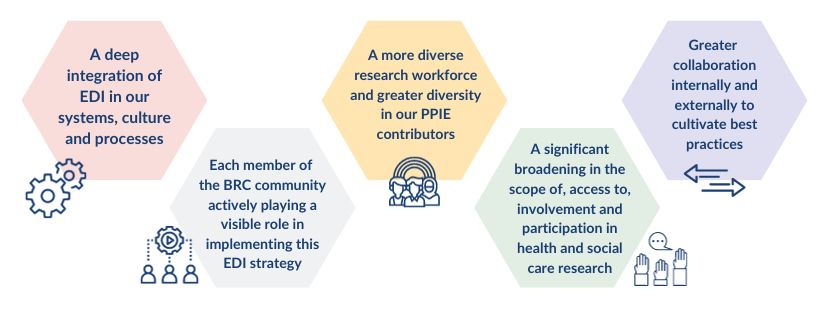
Our NIHR Maudsley BRC Equality, Diversity and
Inclusion Strategy, 2023 - 2028
Published: September 2023
Download a PDF verson of the full strategy here
Background
This strategy outlines our continued vision, goals, and objectives for reducing inequality and embedding the principles of equality, diversity and inclusion (EDI) in our NIHR Maudsley Biomedical Research Centre (BRC) for the 2023-2028 NIHR funding period. It draws on existing EDI directives and best practices from across King’s Health Partners organisations and the NIHR.
This strategy was developed from staff consultations and feedback in the two previous NIHR BRC funding periods and is closely integrated with the overarching strategic priorities for EDI in our host partner organisations, South London and Maudsley NHS Foundation Trust, King’s College London, and the NIHR King’s Clinical Research Facility at King’s College Hospital.
We want our research participants, staff, and students to better reflect the population we serve and to ensure our research protocols are developed with the needs of diverse populations in mind.
Our senior leadership plays a key role in implementing this strategy; and is committed to fostering a culture where all staff and students actively contribute to drive this change.
This strategy will be revised and updated periodically to reflect our progress and evolving relationships with key stakeholders including staff, students and patients engaged in our research.
Our strategy for EDI is closely interlinked with our commitment to increasing patient and public involvement and engagement (PPIE) with our research.
Vision
We will align EDI efforts with our partner organisations to create a genuinely welcoming and inclusive research environment that reflects and celebrates the diversity of our research community - where all individuals feel recognised, valued and supported.
We will promote equity and reduce discrimination and systemic barriers to research participation, training, and career progression. By fostering inclusivity, we will create a sense of belonging and ensure that every member of our community can fully contribute their unique perspectives and talents to advancing the delivery of innovative research outputs and impacts for patient benefit. Through different initiatives, we will cultivate creativity, innovation and excellence, enabling all our stakeholders to thrive and achieve their highest potential.
Our research community refers to two main groups:
- the people we recruit for our research studies, our research participants and those that are represented in our research routine data;
- and the people who conduct and contribute to the research in different career stages - our research and professional services staff, students and PPIE contributors.
Overarching goals
- Increase diversity and representation: of underrepresented groups to ensure protected characteristics (age, sex, gender reassignment, sexual orientation, pregnancy and maternity, marriage and civil partnership, race and ethnicity, disability and religion or belief) and people from disadvantaged socioeconomic backgrounds or facing barriers to access health or social care, are properly represented among our research participants, staff and students.
- Foster inclusivity: with a research culture that accepts and affirms individual differences at all levels of organisational hierarchy and empowers all in the BRC community to realise their full potential.
- Mitigate bias: create a fair and impartial research environment by reducing bias and discrimination in our systems and processes through training, transparent and appropriate governance and objective decision-making, including in the recruitment, promotion, and recognition of staff, and in the recruitment and recognition of research participants and PPIE collaborators.
- Provide support and resources: widen participation and opportunities to engage with underrepresented groups through identifying and addressing barriers to research participation; providing professional development opportunities, mentoring and networking events; foster early career researchers support and development; and share our scientific outputs with transparency, accessibility and availability in different formats.
- Monitor progress: establish transparent monitoring mechanisms across all areas of our research portfolio and regularly use both qualitative and quantitative data to identify areas for improvement and adjust our EDI strategy accordingly.
Successful EDI outcomes for the NIHR Maudsley BRC will include:
- A deep integration of EDI in our systems, culture and processes
- Each member of the BRC community actively playing a visible role in implementing this EDI strategy
- A more diverse research workforce and greater diversity in our PPIE contributors
- A significant broadening in the scope of, access to, involvement and participation in health and social care research
- Greater collaboration internally and externally to cultivate best practices
What we have already done
Increase diversity and representation:
- Targeted efforts to improve the diversity of research participants: including in our Consent for Contact (C4C)
- Assembled internationally leading healthcare data resources that provide uniquely detailed information whole clinical populations, improving representation in research and wider knowledge generation.
Research focus on EDI:
- Race and Ethnicity Advisory Group (READ): this group established in 2021 is composed of 70 members of many different ethnic backgrounds and minoritised communities and provides advice on research studies and supports our researchers.
Support professional development:
- Committees’ composition and leadership: including early career representatives, and members from diverse backgrounds. To provide greater opportunities for diversity in our decision-making processes, we have made open competitions for theme leadership roles. As a result, over the past two rounds, the leadership of the BRC has moved from almost exclusively male to evenly balanced between men and women.
- EDI survey of NIHR Maudsley BRC Academy members: conducted in March 2022 to identify gaps to ensure equality of opportunity for all when planning future recruitment and training.
Collaborate with other partners:
- BRC Youth Awards: launched in 2013. Recognising that careers in research start well before a PhD, these awards aim to provide opportunities for young people (aged 15-18) from schools in the local area taking science, technology, engineering and mathematics (STEM) subjects, being offered a chance to have a placement and mentoring, encouraging them to go on to study these subjects at university. Besides a placement, they include ongoing mentoring for a year and a £50 book voucher.
- Collaborative workshops: for example with the BiPP network in 2020 on
Communication and dissemination:
- Established a BRC EDI champion role in 2012 to lead EDI activities and included EDI as a standing agenda item in every BRC Board meeting to feedback on progress.
- Maudsley BRC EDI online web page promoting the EDI initiatives from across the BRC and partner.
Objectives

Increase diversity and representation:
Action 1: Collaborate with the joint Research and Development office at South London and Maudsley and King’s IoPPN to assess and enhance the documentation of diversity of recruited research participants and PPIE contributors in NIHR Maudsley BRC studies.
Responsibility: BRC Management Committee, BRC Board, BRC Theme and Deputy Theme Leads and Patient and Public Involvement and Engagement Leads.
Action 2: Ensure all major BRC posts and PhD students recruitment calls include EDI monitoring and aggregate data, including on the protected characteristics and socioeconomic status.
Responsibility: BRC Management Committee, BRC Board and Academic Career Development Team.
Research focus on EDI:
Action 1: Promote access to advice on EDI to Maudsley BRC research projects.
Responsibility: BRC EDI Champion, BRC Theme and Deputy Theme Leads, Academic Career Development Team and BRC Principal Investigators.
Action 2: All BRC themes and core programmes to have an EDI lead researcher, who will be responsible for championing local EDI initiatives. The EDI lead researchers will feed back to the EDI Champion so that progress can be reported at the BRC Board recognising their work.
Responsibility: BRC EDI Champion, Theme and Deputy Theme Leads.
Action 3: Establish an EDI PhD student representative role (i.e., one PhD student) championing local EDI initiatives. The EDI PhD student representative will feed back to the EDI Champion so that progress can be reported at the BRC Board.
Responsibility: BRC EDI Champion and Academic Career Development Team.
Action 4: Incorporate EDI into our PhD studentships, and actively encourage people from minoritised groups to apply, including using targeted marketing to attract applicants from under-represented groups.
Responsibility: BRC Theme and Deputy Theme Leads, Academic Career Development Team, BRC Principal Investigators and Communications Team.
Action 5: Promote each PhD studentship to have at least one early career supervisor supported by a more senior colleague, to foster inclusion and professional development of early career researchers within the BRC.
Responsibility: BRC Theme and Deputy Theme Leads, Academic Career Development Team and BRC Principal Investigators.
Support professional development:
Action 1: Widen access to research experiences and opportunities, including for young people from schools and those from under-represented ethnic and socio-economic backgrounds.
Responsibility: BRC Management Committee and Board.
Action 2: Promote access to mentorship programs for underrepresented minority researchers.
Responsibility: BRC Management Committee and Board.
Collaborate with other partners:
Action 1: Build upon existing collaborations and establish new strategic partnerships with organisations that advocate for EDI to foster synergistic efforts and enhance our collective impact.
Responsibility: BRC Management Committee and Board.
Communication and dissemination:
Action 1: Share in an open and transparent way the opportunities to participate in leadership and in advisory groups, to ensure that such opportunities are available to all and to track success and challenges of those involved in such initiatives.
Responsibility: BRC Management Committee and Board.
Action 2: Launch an awareness campaign highlighting BRC researchers from diverse backgrounds. This will promote established EDI role models by highlighting their achievements and promoting senior role models for increased visibility.
Responsibility: BRC EDI Champion, Operations Team, Theme and Deputy Theme and Communications Team

Increase diversity and representation:
Action 1: To monitor and evaluate the diversity of recruitment of research participants and PPIE contributors across BRC-related research studies, collecting diversity data and integrating it into research protocols.
Responsibility: BRC Management Committee, BRC Board Patient and Public Involvement and Engagement Leads, and BRC Principal Investigators.
Action 2: Promote the use of the Equalities Impact Assessments in BRC research studies.
Responsibility: BRC Theme and Deputy Theme Leads.
Research focus on EDI:
Action 1: Develop innovative training resources to guide researchers to routinely collect data on the protected characteristics.
Responsibility: BRC Management Committee and Board.
Action 2: Create awards and celebration events for research that addresses issues related to EDI.
Responsibility: BRC EDI Champion, Operations Team, Theme and Deputy Theme and Communications Team.
Support professional development:
Action 1: Conduct training workshops or focus groups, for researchers to identify and address barriers to research participation, and identify biases present in research towards protected characteristics and from disadvantaged socioeconomic groups.
Responsibility: BRC EDI Champion, Operations Team, Patient and Public Involvement and Engagement Leads.
Action 2: Implement innovative training resources to identify and challenge biases present towards those with protected characteristics and from disadvantaged socioeconomic groups.
Responsibility: BRC Management Committee and Board.
Action 3: Support inclusive leadership within all themes and core programmes.
Responsibility: BRC Management Committee and Board.
Collaborations:
Action 1: Maximise opportunities with other partners within King’s Health Partners, other local partners and beyond (for example, government, industry and NGOs) to promote EDI through knowledge sharing and resources, including joint advocacy and awareness campaigns.
Responsibility: BRC Management Committee and Board.
Communication and dissemination:
Action 2: Launch an awareness campaign highlighting in particular PhD students and fellows from diverse backgrounds who have completed an NIHR Maudsley BRC Academic career development programme and possess different protected characteristics. This will promote future EDI role models by highlighting achievements and increasing visibility.
Responsibility: BRC EDI Champion, Operations Team, Theme and Deputy Theme Leads, Academic Career Development

Monitor progress:
Action 1: Evaluate the effectiveness of the above short- and medium-term objectives in creating a more diverse and inclusive academic career development environment.
Responsibility: BRC Management Committee and Board.

References
Equality, Diversity and Inclusion Strategy 2022-2027 | NIHR
Equality Act 2010: guidance - GOV.UK (https://www.gov.uk/guidance/equality-act-2010-guidance)
Best Research for Best Health: The Next Chapter




